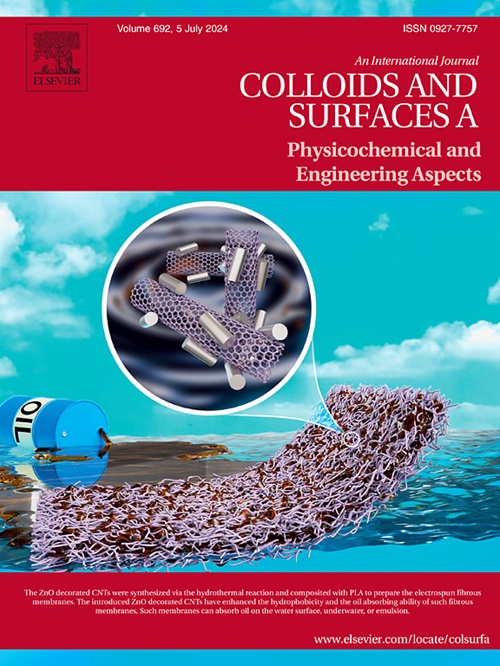Engineering wettability-controlled copper surfaces to mitigate airborne bacterial contamination in hospitals
IF 4.9
2区 化学
Q2 CHEMISTRY, PHYSICAL
Colloids and Surfaces A: Physicochemical and Engineering Aspects
Pub Date : 2025-04-30
DOI:10.1016/j.colsurfa.2025.137085
引用次数: 0
Abstract
Hospital-acquired infections remain a critical challenge in healthcare, with pathogens often proliferating via contaminated surfaces and aerosol transmission through ventilation systems. While copper-based materials are recognized for their intrinsic antimicrobial properties, their real-world efficacy in clinical settings – where factors like surface contamination, exploitation wear, and sanitization protocols interact dynamically – remains underexplored. This study investigates the long-term antimicrobial performance of copper-coated ventilation grates with engineered wettability (ranging from superhydrophilic to superhydrophobic) in the intensive care unit over 325 days. By comparing these surfaces to steel counterparts, we evaluated microbial colonization dynamics under operational conditions, including aerosol-deposited contaminants and routine swab sampling. The analysis of surface wettability and roughness to assess the degradation of deposited coatings and its impact on antibacterial activity showed that for all grates significant alterations in the contact angles from these for the freshly fabricated grates were observed. For the initially superhydrophilic substrate, the contact angle approached 90°, while for the superhydrophobic coating, it deteriorated from 162° to 150°. Results revealed that with respect to various bacterial strains, superhydrophilic and superhydrophobic copper surfaces outperformed both the smoother sputtered copper and the steel, highlighting the efficiency of the extreme wettability surfaces in reducing microbial contamination in clinical settings. After 325 days of clinical exposure, the cumulative number of swabs contaminated with microorganisms from the steel grate was found to be 2.7, 2.3, and 1.4 times higher than the corresponding values for the superhydrophobic, superhydrophilic, and smooth copper grates, respectively. This work bridges the gap between laboratory studies and real-world application and offers a strategy to curb nosocomial infections without disrupting clinical workflows.
工程润湿性控制铜表面,以减轻医院空气中的细菌污染
医院获得性感染仍然是医疗保健领域的一个重大挑战,病原体通常通过受污染的表面和通过通风系统的气溶胶传播扩散。虽然铜基材料因其固有的抗菌特性而得到认可,但其在临床环境中的实际功效——表面污染、开采磨损和卫生处理方案等因素动态相互作用——仍未得到充分探索。本研究调查了具有工程润湿性(从超亲水性到超疏水性)的铜涂层通风格栅在重症监护病房325天以上的长期抗菌性能。通过将这些表面与钢表面进行比较,我们评估了在操作条件下的微生物定植动态,包括气溶胶沉积污染物和常规拭子取样。通过分析表面润湿性和粗糙度来评估沉积涂层的降解及其对抗菌活性的影响,结果表明,所有栅格的接触角都与新制备栅格的接触角有显著变化。对于最初的超亲水涂层,接触角接近90°,而对于超疏水涂层,接触角从162°恶化到150°。结果显示,对于各种细菌菌株,超亲水性和超疏水性铜表面表现优于光滑的溅射铜和钢,突出了极端润湿性表面在减少临床环境中微生物污染方面的效率。经过325天的临床暴露,发现来自钢格栅的微生物污染拭子的累积数量分别是超疏水、超亲水和光滑铜格栅相应值的2.7倍、2.3倍和1.4倍。这项工作弥合了实验室研究和实际应用之间的差距,并提供了在不中断临床工作流程的情况下遏制医院感染的策略。
本文章由计算机程序翻译,如有差异,请以英文原文为准。
求助全文
约1分钟内获得全文
求助全文
来源期刊
CiteScore
8.70
自引率
9.60%
发文量
2421
审稿时长
56 days
期刊介绍:
Colloids and Surfaces A: Physicochemical and Engineering Aspects is an international journal devoted to the science underlying applications of colloids and interfacial phenomena.
The journal aims at publishing high quality research papers featuring new materials or new insights into the role of colloid and interface science in (for example) food, energy, minerals processing, pharmaceuticals or the environment.

 求助内容:
求助内容: 应助结果提醒方式:
应助结果提醒方式:


